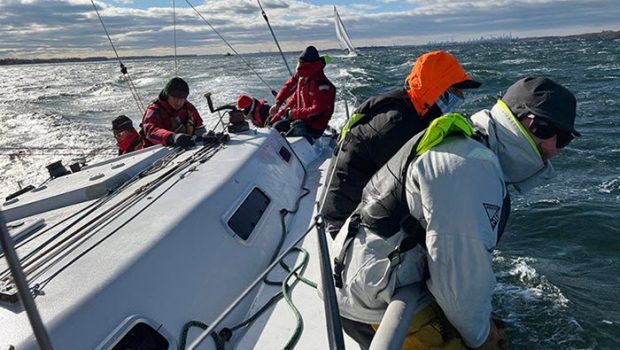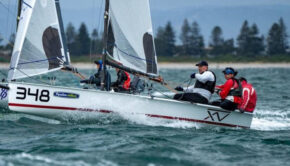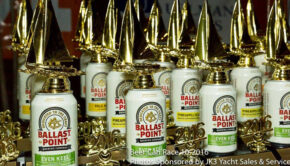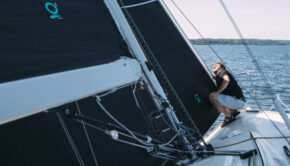Four things that made a difference
Published on December 8th, 2021
Experience is the great teacher as UK Sailmakers reminds us how to meet the challenge of sailing under control in high winds:
Over the Thanksgiving holiday weekend, Huguenot Yacht Club on the Long Island Sound held its annual Turkey Day Reach, the last race for big boats on western LIS. Being in the shoulder season, some Turkey Day Reaches find sailors in short sleeves or light jackets while others make it obvious that December is just a few days away. This year’s was the later.
Forecasts for Saturday called for the unpleasant combination of low temperatures and strong winds. And this time the weather models were right. The temperature was 42 degrees, and the wind blew steadily in the low 20s with gusts into the 30s.
The weather kept many likely sailors home by a warm fire reading the newspaper or watching football. For the few of us who were prepared to race, we will have great memories of meeting the challenge of sailing under control in high winds.
Here are some of the things that made the difference:
————-
• Anticipation – The boats that sailed successfully knew there was the likelihood of challenging conditions. They pre-planned what sails and equipment they would need. Perhaps even more important, they selected a crew that would be able to handle adverse conditions be they temperatures or wind speeds.
• Expectations – They set the expectations for their crewmembers. “Pack warm clothes and don’t be shy about bringing some back-ups in case you get wet,” instructed Adam Loory to his crew on Soulmates. “And, if you think you may not want to sail in these conditions, that’s ok, just let me know.”
• Preparations – When they got to the boats, these sailors organized sails and gear so nothing would go amiss if heeling heavily during the race. The rigs were double checked, Lifeslings were checked, crew roles were assigned, and everyone put on their PFDs (doublechecking any inflatable harness was in charged condition.) Loory even asked crew members to bring their own PFDs if they had one that they knew fit well.
• Execution – When sailing in low 40-degree temperatures with winds gusting between 25 and 32 knots, one has to re-evaluate the risk/reward of mad dash maneuvers. Before the gun, angles were taken and there was no need to “kill” the start in a small fleet reaching race…but rather be on the line and not necessarily fighting for one end or the other.
Tacks, no gybes that day, were talked through well before “go time,” making sure all lines were clear, everyone was aware of their role and in the right position, and those with nothing to do were out of harms way. One final note on execution, with big breeze blowing out of northwest, the Race Committee wisely sent the fleet along the north shore of the Sound to keep the boats out of the heaviest seas and biggest winds.
————-
Some boats, when they got to the starting area assessed the conditions on the course and opted at the last moment to withdraw. That was probably a wise decision if their person-in-charge believed the crew had not adequately anticipated or was not properly prepared for these chilling conditions.
For those that raced, this race will be added to their list of races to be recalled whenever someone in the bar says, “You think that race was cold….!)









 We’ll keep your information safe.
We’ll keep your information safe.